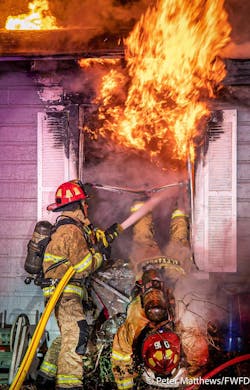As Firehouse Sees It: Is 1/125th of a Second Enough Time for a Complete Size-Up?
I see the hashtag #brotherhood used daily on fire service social media posts, but now I ask myself about the commitment to the “brotherhood” after one of my photos went viral last month. For a few days, as I examined the comments closely on various accounts, I thought maybe a new hashtag—#TheBrotherhoodIsEroding—would be necessary.
Hundreds were quick to rush to judgment, questioning tactics that were employed by people they don’t know in a department that has operations they are likely unfamiliar with. Those critics also didn’t know all of the circumstances, so their size-up of the situation was skewed. The photo that they questioned was captured in 1/125th of a second in an area about one-story high by eight feet wide.
The photo that I am referring to is the one that’s on the cover of this issue, which was taken in Fort Worth, TX. Bitterly cold weather (for Texas) blanketed the area, so I spent the better part of the day riding with Engine 5 to take some photographs. (The crew responded to a handful of structure fires amid other calls.) I came home to get ready for work the next day when crews were dispatched to a house fire that was within a mile of my home.
The response
Engine 16 and Quint 16 arrived to find fire showing from the Bravo side of a one-story, 700-sq.-ft. house. Fire still was showing when I arrived. The crews got a quick knockdown from what I could see from the outside. It appeared to be nothing more than your routine house fire. I know that there is no such thing as routine, however, this appeared normal from the fires that I photographed over the years.
I was taking a cellphone video when I saw conditions changing rapidly. The smoke started to get darker and violent. Within moments, the smoke was igniting. In mere seconds, flames engulfed the front room where Capt. Brian Alexander, who is a veteran member of the department, was operating. The remaining crews were in other parts of the house.
Contents from hoarding conditions near the front of the house started to reignite. Alexander called for a second hoseline to darken down debris fire, but he grabbed a booster line (red hose) that was on the front steps that previously was used to knock down fire that ran the eaves outside of the house.
He said that he felt the heat intensify and instantly found himself surrounded by flames. “The room went orange,” Alexander told me later.
Capt. Larry Young saw the conditions changing, picked up the backup line that was being stretched, yelled to Alexander to exit the structure and aimed the nozzle above Alexander’s body as he bailed out.
So quick to judge
Social media quarterbacks questioned why Young wasn’t masked up. The reason: They were in the process of stretching the line when the flashover happened. Why was the nozzle bale “only at half?” some asked. Young opened it quickly to get water on the fire, despite flames licking out over Alexander’s body.
It was less than 25 seconds from when the flashover was visible until Alexander, with the backup line in his hand, made the push back through the front door and knocked down the fire to ensure that the others who were inside were safe.
Build up, don’t break down
As famed radio broadcaster Paul Harvey said to end his segments, now you know the rest of the story.
It was a shame to see the harsh, negative comments about what is shown in the photo. Don’t get me wrong, photos and videos are great for training when they are used in proper context. However, roasting a brother or sister on social media, for the public and family to see, doesn’t serve much purpose. That is the erosion of the brotherhood that social media allows.
There have been positive and encouraging reasons to use social media: new friends, reconnecting with old ones, finding groups comprising like-minded people that you otherwise never would meet in person. However, after this photo was shared all over, it was frustrating to get online, because the support of the brotherhood was gone. We should use the medium to build each other up, not break each other down.
Who can see the whole scene in 1/125th of a second and call the strategies? No one can. So why rush to judgement based on that short time frame that’s captured on camera?
About the Author
Peter Matthews
Editor-in-Chief/Conference Director
Peter Matthews is the conference director and editor-in-chief of Firehouse. He has worked at Firehouse since 1999, serving in various roles on both Firehouse Magazine and Firehouse.com staffs. He completed an internship with the Rochester, NY, Fire Department and served with fire departments in Rush, NY, and Laurel, MD, and was a lieutenant with the Glenwood Fire Company in Glenwood Landing, NY. Matthews served as photographer for the St. Paul, MN, Fire Department and currently is a photographer for the Fort Worth, TX, Fire Department.

